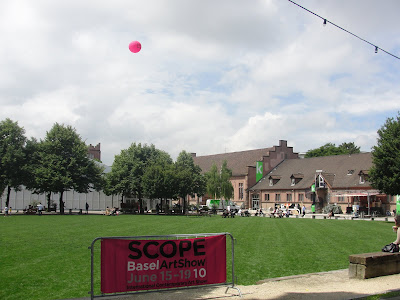Take the experience I had at Liste and consider its opposite: that’s what Volta turned out to be. Engaging, lively, and friendly. Perhaps because it is located in a difficult part of the city to reach, it was great to feel like my presence was welcome. And of course, the art also impressed.
The intersection between historical subject matter and contemporary issues seemed to prevail at the fair. As seen in Nandipha Mntambo’s hanging relief sculpture as well as in Alexander Tinei’s painting which intersected well with the scientific in Herwig Weiser’s Death before Disko and Rafael Lozano-Hemmer’s The Company of Colours. Also the edition artist of the fair was Troels Carlsen. His work was set apart from the other galleries and artists and given its own wall, much like at Robert Montgomery’s installation piece at the entrance of the Scope fair.
Death before Disko was particularly spellbinding. As I stood in front of the noisy and bright glass container, I realized that within the central area the very cold hardware was moving. The liquid was pulsating and it became very alive in my mind. When intersected with the electric sounds from below the contraption and warmth emitting from the sides, it felt like I was in the midst of a Frankenstein experiment. This very technological work was coming to life before my eyes.
After a few minutes I broke free from my trance and asked the gallerist some questions. She explained that the black ‘goo,’ for lack of a better term, dimples and spins due to a dual magnet pull. The gallery describes that the piece is meant to “return to the foundations of hardware” to “show how our relationship towards technology is more often emotional than rational.” Considering my initial reaction, I think the piece is rather successful.
speaker, plexiglas,motor, magnetic liquide, light-emitting diode, pc
Galerie Colletpark, Paris
Troels Carlsen, View of Several Works at Volta
120 x 100 cm, Oil on Canvas
Shadow Box 9, Edition 1 of 6, 1AP
High resolution interactive display with built-in computerized surveillance system
bitforms gallery, New York






















